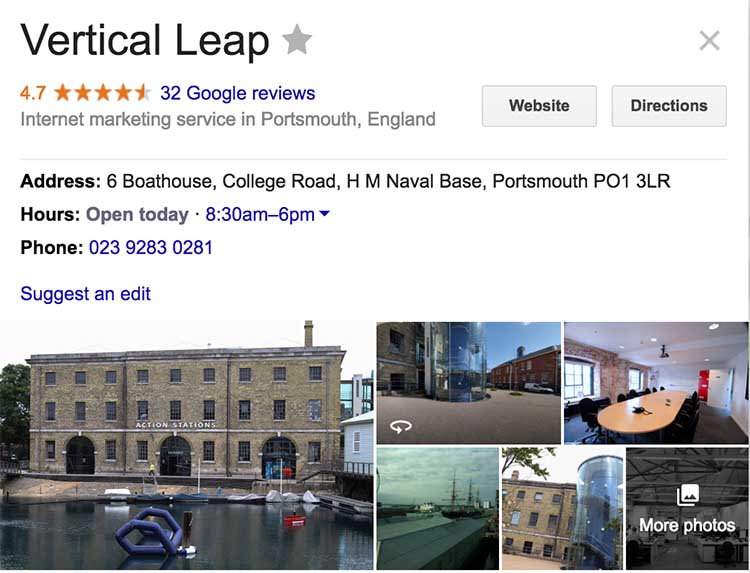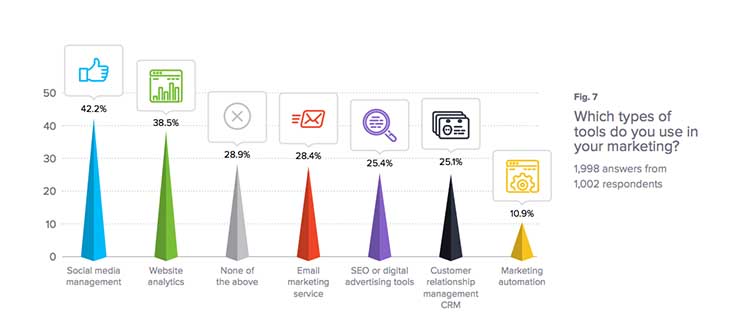Search engine optimization isn’t always much fun for small businesses. Aside from having to compete with your closest rivals, you’ve got those industry leaders hogging up page one of results.
To make matters worse, organic results are getting pushed further down the page, leaving less space for the little guy. These are the challenges small business marketers face, but each of these challenges is also an opportunity to get ahead of your competitors. Here are ten things every small business should be doing with their SEO strategy.
#1: Local SEO
We may as well start with the obvious one. Unless you happen to be a small online-only retailer, chances are you have brick-and-mortar stores or offices. Which means local SEO is going to be a core part of your search marketing efforts. Below is an example of a local listing in Google:
image: http://cdn2.business2community.com/wp-content/uploads/2017/09/local-seo-listing.jpg
There’s more to local SEO than Google Maps, though. First, you have third-party directory and review sites to think about – both of which Google uses for search and Google Maps results. You’ll also want to localise your content strategy and work location names into anchor text, URLs, headings, etc.
#2: Tactical link building
Link building is tricky for every business so don’t let this one get you down. Just keep in mind that quality outweighs quantity when it comes to inbound links – so focus on getting links from sites with a higher domain authority than yourself.
These are some techniques to try:
- Guest blogging: The classic link building technique still works today.
- Syndication: Targeting trusted publishers that syndicate content can increase the number of links, traffic and audience you gain from guest blogging.
- The Skyscraper Technique: Find popular content, publish an improved version and reach out to the sites linking to the original piece.
- Broken link building: Find broken links to popular content and provide these sites with a replacement version.
Of course, your content needs to be good enough to earn those essential links and shares. Until your audience is large enough that link building largely takes care of itself, you’ll have to be tactical with your approach.
#3: Reach out to local/relevant publications
Another good link building strategy is to reach out to local/relevant publications. It’s not only the links you’re after, though. Google likes to see your brand mentioned in publications relevant to your industry or in your local area – so even if you don’t get links, simply being mentioned is beneficial.
The other main benefit with local and relevant publications is their audience. Links mean potential traffic, citations mean brand awareness and regularly featuring in these publications means you can tap into their regular audience.
#4: Exploit your competitors’ weaknesses
Your closest competitors are facing all the same challenges you are. Use this to your advantage. Are they missing out on obvious keyword opportunities? Are they suffering from poor reviews on Google My Business? Is their website painfully slow to load or poorly optimised for mobile?
image: http://cdn.business2community.com/wp-content/uploads/2017/09/Apollo-3-screens.jpg
Apollo Insights offers in-depth competitor analysis to help you pinpoint their weaknesses
Every weakness your competitor shows is an opportunity to beat them, show users you’re the better brand and prove to Google you should rank higher than them.
#5: Get a head start with AdWords
While SEO is a long-term process of building an online presence, AdWords is a much faster way of bringing traffic to your site. It’ll take time for your SEO strategy to generate any kind of ROI but advertising on AdWords allows you to generate profit as your organic presence builds up.
AdWords isn’t simply a shortcut to getting traffic on your site, though. It allows you to target users who aren’t looking for content anymore; they’re looking to buy. There’s a reason Google charges to advertise on its search engine – because it generates the kind of high-quality leads you can’t get elsewhere.
#6: Target high-intent users with your SEO strategy
Unlike paid advertising, SEO largely focuses on users who are still looking for content. Generally speaking, these are people who haven’t quite made up their minds yet. They might know they want to buy a new TV, but they’re not sure which model to go for. Essentially, they need help making a buying decision.
It’s important to understand what users look for as they progress along the buying journey. For example, someone who has booked a holiday but needs a hotel is very high-intent. They need a place to stay and it’s simply a case of finding the best place within their price range.
So let’s say you’re a small hotel, here’s your content idea: “Top 10 hotels in [location] for any budget”. Make this an evergreen piece of content that builds search authority over time and is always there for people looking for a room in the area.
#7: Target lower-intent leads as your SEO strategy matures
We all love high-intent leads but they’re sadly the minority of your potential customers. The vast majority are low-intent and end up doing business elsewhere, unless you capture them early enough and bring them closer to the sale.
Instead of looking for hotel rooms in your area, these people are still considering where to go on their holiday. So you’re recommending destinations rather than hotel choices at this earlier stage of the consumer journey.
#8: Website speed, bounce rate, etc.
Websites that offer a poor user experience aren’t much good to Google. The search giant wants to send users to pages that load quickly, are well-optimised for mobile and – above all – provide the content people are looking for.
Make performance a priority (speed, mobile optimisation, etc), refine your content to keep people on your page (reduce bounce rate) and guide users to the next relevant page.
#9: Automate everything you can
One of your biggest challenges as a small business is marketing efficiency. Keyword research, competitor analysis and everything else takes valuable time – all of which adds up very quickly.
The answer? Automate everything you can to cut down the workload of repetitive, time-consuming tasks.
image: http://cdn.business2community.com/wp-content/uploads/2017/09/autom8.jpg
Infusionsoft’s 2017 Small Business Marketing Trends Report reveals that automation is not a priority for most small business owners. Which means this is another one of those competitor weaknesses you can exploit while they’re busy updating their Facebook status.
#10: Build an in-house team or hire an agency
The biggest misconception with small business SEO is that budgets are the main barrier. Whereas the real thing that stops a lot of smaller brands building a solid search presence is resources – i.e. not having the right team on board.
Going back to the Infusionsoft report, small business owners also tend to be the marketing manager for their brand. The problem is most small business owners aren’t marketers and they’re too busy running a business to dedicate the time it takes to build an online presence. Our advice – build a decent in-house marketing team or hire an SEO agency.
We understand SEO can be frustrating for smaller businesses but it doesn’t have to be an uphill struggle. With the right personnel on board, and automation taking care of reports and other technical SEO tasks, you’ll start to see real progress.
Small businesses have a lot to gain from the latest marketing technology. Agility is one of the biggest advantages you have over bigger brands so move quickly to adopt the latest SEO technology and techniques – this is the best chance you’ve got at jumping ahead of your competitors and giving bigger businesses something to think about.
502.822.6695
team@guardianowldigital.com

 There’s more to local SEO than Google Maps, though. First, you have third-party directory and review sites to think about – both of which Google uses for search and Google Maps results. You’ll also want to localise your content strategy and work location names into anchor text, URLs, headings, etc.
There’s more to local SEO than Google Maps, though. First, you have third-party directory and review sites to think about – both of which Google uses for search and Google Maps results. You’ll also want to localise your content strategy and work location names into anchor text, URLs, headings, etc.
 Infusionsoft’s 2017 Small Business Marketing Trends Report reveals that automation is not a priority for most small business owners. Which means this is another one of those competitor weaknesses you can exploit while they’re busy updating their Facebook status.
Infusionsoft’s 2017 Small Business Marketing Trends Report reveals that automation is not a priority for most small business owners. Which means this is another one of those competitor weaknesses you can exploit while they’re busy updating their Facebook status.
Recent Comments